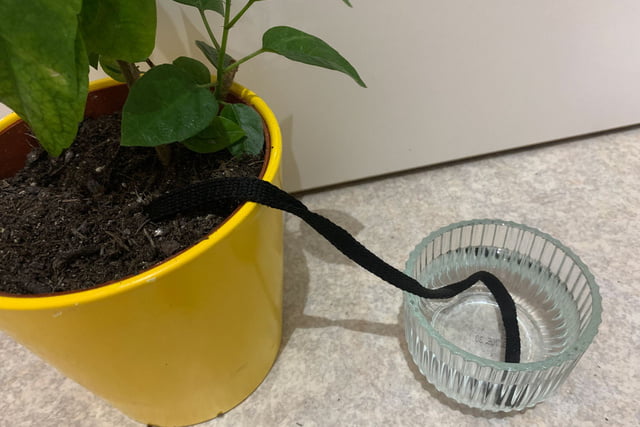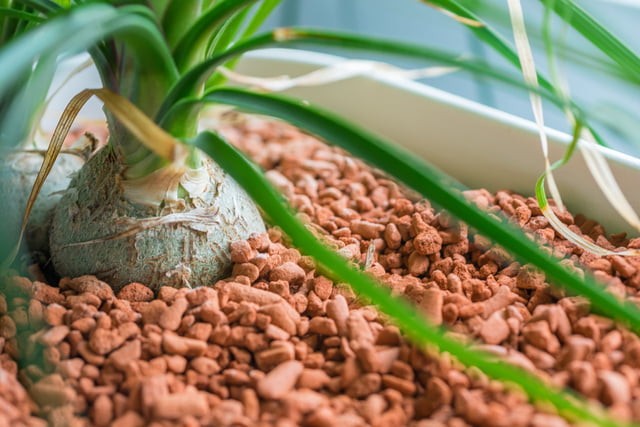With our seven ideas for self-watering potted plants, you no longer have to hope for help from friends or neighbors.
Summertime is vacation time and if you have no one to take care of your potted plants for the next trip, you can help yourself with one of the following solutions that work completely self-sufficiently and without much effort:
self-watering from the bottle.
A cone of porous clay* screwed onto a water bottle is an ingeniously simple way to provide water to potted plants over a period of eight to 25 days. The bottle with the attachment is simply inserted into the flower pot.
To avoid negative pressure, a small hole must be made in the bottom of the bottle. The tops are available for different pot sizes*. A two-liter bottle is sufficient for a pot up to 40 centimeters in diameter for about ten days.
Build your own irrigation system from a bottle
As an alternative to the clay cone on the bottle, you can easily build a similar watering system for your houseplants yourself. For this you only need a bottle, and a nail as long as possible.
Provide the plastic lid of the bottle with one to three holes, depending on the water needs of the plant.
Then fill the bottle with water. Put a nail, as long as possible, through one of the holes so that it sticks out the top. It will hold the bottle upright later.
Close the bottle and stick it upside down into the soil until the bottle has a secure hold.
How long this vacation watering system lasts depends on how big the bottle is and how big you make the holes in the bottle cap. However, keep in mind that the larger the bottle, the harder it will be to give it a stable hold.
automatic watering – watering balls
Somewhat more elegant than a PET bottle are so-called watering balls made of glass*. These are partially colored spheres of various sizes (usually between five and eight centimeters in diameter) with a long stem at one end.
The ball is filled with water and the style is then inserted into the soil at least half the height of the pot. How long a filling of the irrigation ball is sufficient depends on the size of the ball and the water needs of the plant.
watering cord as automatic irrigation.

If it is a question of watering your plants for just a few days, a simple string and a glass of water is very suitable. This method works quite reliably for small pots up to about 20 centimeters in diameter. If you pass the cord through a straw, it will not dry out and water will not drip next to it.
Simply fill a slightly elevated container with water and hang a thick string, such as shoestring or thick yarn, in it.
Put the other end of the string into the soil of the plant and bury it near the roots to half the depth of the pot. If the soil in the pot becomes dry, it will automatically “suck” water from the reservoir via the damp string.
Tip: Do not use sheep’s wool as yarn – this material contains a lot of fat and absorbs little water.
self-watering – the towel trick.
There are special watering fleeces* available in stores that hold absorbed water for a long time and serve as a water-giving saucer for the plant.
An inexpensive solution to water plants is the towel trick:
- Place an old towel in the bathtub and soak it with water.
- Place the plants directly on the towel without a planter.
- This will allow the soil to soak up as needed.
water reservoir for several plants at the same time
You can install several plants with one water reservoir at the same time using a whole system of clay cones* and hoses. To do this, the irrigation clay cone is inserted into the soil. This is supplied with water from a tank through a hose, thus watering the plant. The installation is, in contrast to the PET bottle tops, a bit more complicated. In addition, a sufficiently large water tank is necessary, which is located between the plants.
watering plant on vacation with granules.
Plant granules made of expanded clay* or Seramis* are ideal water reservoirs and are used by many plant lovers even outside the vacation season. For longer absences, the granules can also be used once.
To do this, fill a layer of granules at least five centimeters thick into a large plastic tub.
Place the pots on top without a planter and continue to fill the tub with granules until the pots are about half covered.
Then water the granules until they are fully soaked.

More interesting facts about expanded clay and what you can also use it for, you can learn here.
the self-watering pot
A number of retailers now offer self-watering flower pots*. These are often double-walled plastic flower pots with a cavity between the inner and outer walls. Other models have the water reservoir built into or into the bottom of the pot.
The tank or cavity is filled with water and releases it to the plant as needed. Self-watering flower pots often have an integrated water level indicator* (also called a watering indicator).


